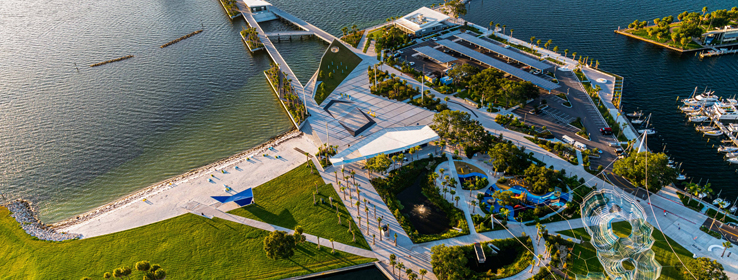Architects Harold Somarriba and John Curran describe how sustainable features shine in the design for the newly reimagined St. Pete Pier in St. Petersburg, Florida.
For nearly 170 years, there has always been a pier presence in downtown St. Petersburg, Florida. The latest iteration — which opened in the summer of 2020, in the same spot as all the others — connects the city to the water unlike its predecessors. “The pier is an outdoor living room for the city,” says architect Harold Somarriba, principal at Wannemacher Jensen Architects. “That was something that was missing with the previous pier, which kind of just dissolved into a large parking lot and a transitional space to get to the pier head.”
In place of that parking lot and a busy road, people now find a welcoming park, market space and restaurant, all designed by Somarriba’s team in collaboration with W Architecture & Landscape Architecture. They connect with The New St. Pete Pier — which includes the Tampa Bay Watch Discovery Center and pier head — designed by ASD|SKY, Rogers Partners and Ken Smith Workshop. Architect John Curran, principal at ASD|SKY, led this team of collaborators to set the standards for the comprehensive public space called the Pier District. Many of the structures feature Sherwin-Williams paints and coatings, including ProMar® 200 Zero VOC Interior Latex on interior drywall and Pro Industrial™ High Performance Acrylic on interior and exterior steel trim.
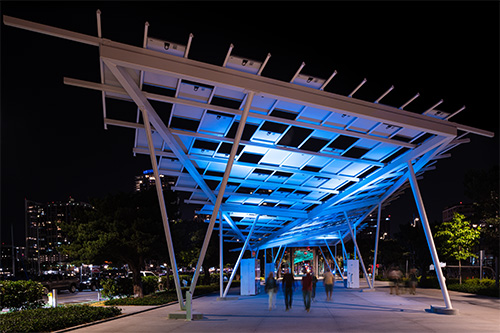
LED lighting fixtures that project a full spectrum of color brighten the Pier Market shade structures at night. A primer coat of Macropoxy® 646 Fast Cure Epoxy and two coats of Pro Industrial™ Waterbased Acrolon™ 100 Polyurethane cover the galvanized steel surfaces.
From the start, the goal was to create engagement and activity throughout the park, instead of just the pier head. “Otherwise, it would have just been some kind of promenaded landscape, and you would have had to go all the way back to the pier, near the water’s edge, to first engage in that experience,” Somarriba says.
The Pier Market
So they devised the Pier Market, roughly 6,000 square feet of shade structures that host a marketplace with local vendors several days of the week and include specially designed “pods” where vendors can store and sell their merchandise. For the shade structures’ inspiration, Somarriba’s team looked at shade structures in nature — trees. “When you first approach a tree canopy, you have the sparse shade and leaves and branches, but as you get close to the center, it’s denser.” The Pier Market structures function in a similar way, he says.
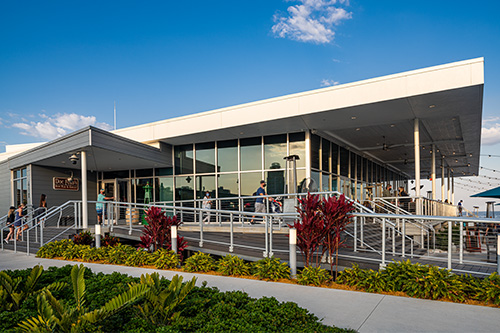
Doc Ford’s Rum Bar & Grille, designed by Wannemacher Jensen Architects and one of five restaurants at St. Pete Pier, takes in sweeping views of Tampa Bay and downtown St. Petersburg. Exterior stucco surfaces are coated with Loxon® Concrete & Masonry Primer/Sealer and two coats of A-100® Exterior Latex Paint; exterior metal finishes are coated with Pro Industrial™ Pro-Cryl® Universal Primer and Pro Industrial™ Acrylic Paint.
But the shade canopy doesn’t include an ordinary roof. Instead, the canopy is made up of 442 solar panels. “We thought, ‘How do we integrate the solar system so that it’s not something that’s hidden up above a roof plane?’” Somarriba says. “So often, that’s what you see above parking lots and buildings. But it usually isn’t something that has the presence we were able to achieve with these market structures.”
That kind of visibility allows the solar panels to become learning tools, Somarriba says. “Kids can go there for field trips and can see this and say, ‘OK, this is how the solar system array works. These are the components — you have your panel and the wires connecting to the inverters that take the electricity back to the city or to some other place.’” In this case, energy produced ties to a rollback meter that goes back to the electric utility, and the city of St. Petersburg receives a credit.
The system’s conduits and connections are concealed within sleek galvanized steel V-columns holding the solar panels. “We wanted to maintain as clean of a look as possible,” Somarriba says. All steel surfaces are painted white, which helps reflect heat. “We wanted to make sure it could stay as cool as possible in the summer,” the architect says.
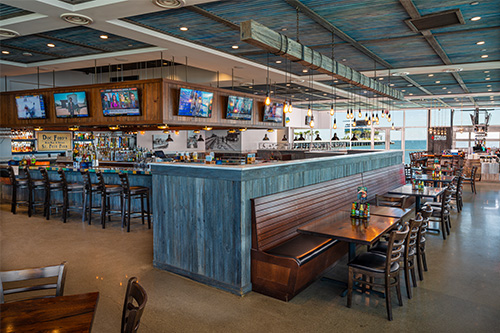
The interior of Doc Ford’s Rum Bar & Grille features ProMar® 200 Zero VOC Interior Latex on drywall and H&C® Clear Liquid Hardener & Densifier on concrete.
Ensuring coatings would stand up to marine and city environmental conditions was also a priority. “We tested the coats, bringing samples of the galvanized steel to the site about 6–7 months prior to the installation of the units, and had them coated with Macropoxy paint to see what the reaction would be,” Somarriba says. “We saw no issues, and that gave us the confidence we wanted to go ahead and use that as the coating system.” The exact specifications were a primer coat of Macropoxy® 646 Fast Cure Epoxy followed by two coats of Pro Industrial™ Waterbased Acrolon™ 100 Polyurethane.
But the bright structures shine beautifully at night, too, thanks to LED lighting that can project a full spectrum of color. “It gives us the ability to animate the market at night and look at the different seasons and holidays,” Somarriba says. “And we can then tune the lighting so people can participate within that activity.” And participate they have. “It’s definitely become a living room for the city, for people, to use.”
The New St. Pete Pier
Like the Pier Approach, The New St. Pete Pier creates spaces that support a variety of activities throughout the Pier District. For the previous pier, the main draw was a restaurant and shops at the very end. But the new pier’s appeal is entirely different. “What we were trying to create was not a destination at the end of the pier, but a place where everywhere you went was the destination,” says architect John Curran of ASD|SKY.
What once was primarily a road is now a pedestrian experience that better integrates with the bay, where new breakwaters have been placed to protect seagrass and minimize erosion on Spa Beach. “What we created was the ability for the seagrass that existed here to thrive and grow underneath the pier,” Curran says. “By expanding the ecosystem, we helped Tampa Bay. We helped that whole ecological network come alive.”
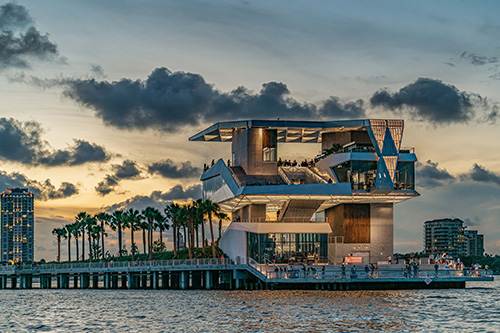
The dramatic pier head includes a green space called the Grate Lawn, three restaurants, a shop and a fishing pier that steps down toward the water.
From there, it was a matter of helping people literally experience the water. That includes opportunities at the Discovery Center on the pier. Run by Tampa Bay Watch — an organization working to protect and restore the bay estuary — the facility includes a “wet classroom.” “You have the ability to go down into our classroom and actually touch the water,” Curran says. But connections to the water are much simpler, too, including the fishing deck at the end of the pier. “We strategically put it only five feet above the water,” Curran says. “Again, it’s all about getting people closer to the water and experiencing that activity.”
Sherwin-Williams coatings protect many key surfaces, including the pier’s steel rails. “Oftentimes, except for color, coatings may seem to take a backseat to what we do,” Curran says. “That’s because what they’re doing is protecting materials that were specified — in this case, high-performance coatings that were used for the steel networks and even PVC fire line under the deck. People don’t realize how important all of that is.”
Want to see more of the St. Pete Pier? Visit Sherwin-Williams Design Pros on Instagram.
Aerial and pier head photos by Rich Montalbano; Pier Market and Doc Ford’s photos © Randy Van Duinen


